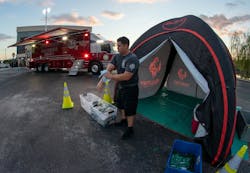Home Runs at the Station Design Conference
The Cardinals didn’t play in St. Louis during the 2023 Station Design Conference last month, but “home runs” prevailed according to the conference’s 574 attendees and exhibitors. The hard-hitting speakers focused on one track on the basics of starting a project for rookies. The second track for seasoned attendees included case studies and advanced topics. The third track targeted law enforcement projects and the fourth track offered trends and innovations for combined facilities and emergency operation centers.
Approximately 85 percent of the audience were first-time attendees. Of the 73 exhibitors, 16 companies were also new to the conference. The goal of the conference was “win-win” for all participants with an emphasis on educational programs and networking opportunities.
A strong foundation
Opening the General Session, “A Strong Foundation: Getting the Right Start for a Public Safety Design,” Ken Newell, Stewart-Cooper-Newell Architects, once again offered his ever-popular popular 30,000-foot overview of the designing and building of a public safety facility. Subsequent presentations at the conference would dig down into topics related to project management.
“The most expensive part of the costs will be the unseen, below the ground,” said Newell, encouraging a geotechnical study of the building site. He also suggested, “Always consider adjacent property acquisitions.” While not required initially, the adjacent property will be a good investment for the future and the investment will most likely increase over the years if it's not needed.
Presentations included initial steps such as selecting the team for the building committee and determining and working with the selected architectural firm. In “Learning How to Read Blueprints,” Jeff Humphreys and Brett Hanson, principals, MACKENZIE., shared how to build confidence in working with architects by learning about building blueprints and other documents.
Key takeaways from Humphreys and Hanson’s presentation were to know that all documents are complementary to one another; It’s important you are part of the review process; and don’t hesitate to ask your design team for a tutorial to understand the drawings page-by-page.
It’s in the details
With a focus on the interiors, Ray Holliday and Marcus Gibbon, Brown Reynolds Watford, presented “A Million Little Things—Details to Make Your Station More Functional.” We didn’t count, but the duo shared a full hour’s worth of tips and suggestions to get the most investment out of the new station.
Examples of single dorm rooms started at the top with acoustical ceilings with sound absorption and sound blocking and as well as a remote-control ceiling fan. Three in-room lockers (one for each shift) with adjustable shelving and bottom drawers should include self-closing hinges and cabinet silencers. A California twin bed, with three drawers underneath, had a handy upholstered bench seat at the end of the bed.
In a couple of slides, bedroom corridors lead straight to the apparatus bay, including low-voltage lighting and luxury vinyl tile that absorbs sound and offers a rustic look. Single-use restrooms had vacancy notification door hardware and ADA-approved door handles.
The future is now
Two programs about future stations were a reality check that the future is now. Patrick Stone and Dennis Ross, H2M Architects, dove right into “Fire/Rescue Stations of the Future” with a range of issues that will impact the fire and emergency services. Departments are currently facing electric vehicles (EVs) and soon, hydrogen vehicles, climate change, and urban unrest. The costs of buildings and interiors will only increase. “Renovating your station to accommodate new technology and equipment will be far more expensive in years to come.”
Consider the needs and storage space for not only EVs but aerial fighting (drones), and robotics. Expect trends in enhanced on-scene decontamination equipment at an incident. Fire station use of biometrics with touchless security and integration, real-time well-being analysis and reduction of sleep deprivation.
In “Mission Critical Microgrids,” Michael Benson, MPA, EFO, Command Consulting, LLC., explained the impact EVs have on fire and emergency facilities. According to the U.S. Department of Energy, microgrids are described as “A group of interconnected loads and distributed energy resources within clearly defined electrical boundaries that act as a single controllable entity with respect to the grid.” (U.S.D.O.E. 2012)
EVs require a charging system every day, quick charging for busy shifts and with an unstable grid, the ability to charge when the power is out. “Is that available from your utility company?” Benson asked. “What about a lengthy incident?”
Lastly, the popular annual program, “Taking it Home: Facing Reality” was moderated by Rob Manns, MW Studios. The “improv” role-play scenarios demonstrated the questions and situations conference attendees could face returning armed with a new approach and ideas for their project. While light-hearted, the impromptu roadblocks thrown into each scenario mirrored real life. It certainly was an eye-opener.
We can look to the future when it comes to the 2024 Station Design Conference, May 20-23, at the Renaissance Hotel, Glendale, AZ. We hope you will participate in the conference next year and once again, I promise you won’t be disappointed.

Janet A. Wilmoth | Special Projects Director
Janet Wilmoth grew up in a family of firefighters in a suburb of Chicago. Wilmoth, who is owner of Wilmoth Associates, worked with Fire Chief magazine for 27 years until it closed in 2013. She currently is the project director for Firehouse, overseeing the Station Design Conference.






